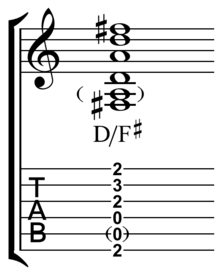Standard tuning
 From Wikipedia the free encyclopedia
From Wikipedia the free encyclopedia
In music, standard tuning refers to the typical tuning of a string instrument. This notion is contrary to that of scordatura, i.e. an alternate tuning designated to modify either the timbre or technical capabilities of the desired instrument.
Violin family[edit]
The most popular bowed strings used nowadays belong to the violin family; together with their respective standard tunings, they are:
- Violin – G3 D4 A4 E5 (ascending perfect fifths, starting from G below middle C)
- Viola – C3 G3 D4 A4 (a perfect fifth below a violin's standard tuning)
- Cello – C2 G2 D3 A3 (an octave lower than the viola)
- Double bass – E1 A1 D2 G2 (ascending perfect fourths, where the highest sounding open string coincides with the G on a cello).
- Double bass with a low C extension – C1 E1 A1 D2 G2 (the same, except for low C, which is a major third below the low E on a standard 4-string double bass)
- 5-stringed double bass – B0 E1 A1 D2 G2 (a low B is added, so the tuning remains in perfect fourths)
Viol family[edit]
The double bass is properly the contrabass member of the viol family. Its smaller members are tuned in ascending fourths, with a major third in the middle, as follows:
- Treble viol – D3 G3 C4 E4 A4 D5 (ascending perfect fourths with the exception of a major third between strings 3 and 4)
- Tenor viol – G2 C3 F3 A3 D4 G4 (a perfect fifth below the treble viol)
- Bass viol – D2 G2 C3 E3 A3 D4 (an octave lower than the treble viol)
- 7-stringed bass viol – A1 D2 G2 C3 E3 A3 D4 (an extra low A is added)
A more recent family is the violin octet, which also features a standardized tuning system (see page).
Guitar family[edit]


Guitars and bass guitars have more standard tunings, depending on the number of strings an instrument has.
- six-string guitar (the most common configuration) – E2 A2 D3 G3 B3 E4 (ascending perfect fourths, with an exception between G and B, which is a major third). Low E falls a major third above the C on a standard-tuned cello.
- Renaissance lute – E2 A2 D3 F♯3 B3 E4 (used by classical guitarists for certain pieces; identical to standard guitar tuning, except for the F♯, lowered one semitone from the standard G string, placing the major third between 3rd and 4th rather than 2nd and 3rd strings)
- seven-string guitar – B1 E2 A2 D3 G3 B3 E4 (identical, except for the low B, which is a perfect fourth below the low E on a 6-stringed guitar)
- four-string bass guitar (most popular) – E1 A1 D2 G2 (its standard tuning coincides with that of a 4-stringed double bass)
- five-string bass – B0 E1 A1 D2 G2 (identical to 4-stringed bass with the addition of a low B string a perfect fourth below the E).
- six-string bass – B0 E1 A1 D2 G2 C3 (identical to 5-stringed bass with the addition of a high C string a perfect fourth above the G).
- Baritone (older use) / 6 string bass (older use) such as the Fender Bass VI – E1 A1 D2 G2 B2 E3 (Similar to a standard guitar but an octave lower, and often played like a standard guitar rather than a bass guitar.)
- Baritone guitar (contemporary versions) – B1 E2 A2 D3 F♯3 B3 a fourth below standard tuning, although A1 to A3; a fifth lower is also used.
- 12-string guitar E3 E2 A3 A2 D4 D3 G4 G3 B3 B3 E4 E4 in six two-string courses.
Other[edit]
Other plucked string instruments and their respective standard tunings include:
- Banjo (Five-stringed): G4 D3 G3 B3 D4 for bluegrass; old time and folk banjoists use this and a wide variety of other tunings
- Mandola: C3 G3 D4 A4 (same as standard viola tuning)
- Mandolin: G3 D4 A4 E5 (same as standard violin tuning)
- Pipa: A2 D3 E3 A3 (most common and used in Chinese orchestra; several other tunings exist)
- Balalaika (Prima): E4 E4 A5 (the two identical Es are on strings of different gauges)
- Requinto Jarocho: A3 D3 G3 C4 (G string tuned the same as a guitar's)
- Ukulele (Soprano): G4 C4 E4 A4 (C6) and A4 D4 F♯4 B4
See also[edit]
References[edit]
- Oprea, Gheorghe (2002). Folclor muzical românesc. Bucharest: Editura Muzicală. pp. 102–105. ISBN 973-42-0304-5. OCLC 254864734.